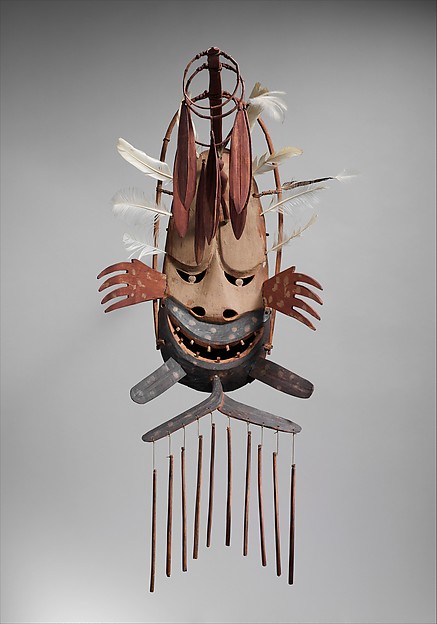
North Wind Mask (Negakfok), Alaska, Yu’pik, early 20th century, wood and feathers (Metropolitan Museum of Art)
The Bering Sea, on the western coast of Alaska, is home to the Yup’ik peoples. This area has one of the world’s coldest climates, making for very challenging living conditions. Yup’ik men carved and painted masks to occupy them while indoors during the long dark winter months (when temperatures could fall to -48 degrees Fahrenheit).
These masks played important social and ceremonial functions during dances, actively participating in the communal, spiritual life of the Yup’ik. Masked dances celebrated spiritual transformation, but were also intended to herald the coming of springtime or to bring good fortune to an upcoming hunt.
The Yup’ik
The Yup’ik, or Yupik (“Real People”), people come from Alaska (comprised of the Central Yup’ik and the Alutiiq). They are related to other Indigenous groups or First Nations including the Inuit in Canada, the Yuiit or Siberian Yupik (also referred to as Chukchi in Siberia) and Iñupiat in Alaska, who have all been incorrectly lumped together as “Eskimos.”
Prior to contact with foreigners (such as Russians, Europeans, and Euro-Americans), the Yup’ik turned to the ocean for their livelihood. They fished and hunted sea mammals, and often moved with the seasons to follow these sources of food. Many Yup’ik communities still live along the Alaskan coast—and continue to draw on these natural resources.
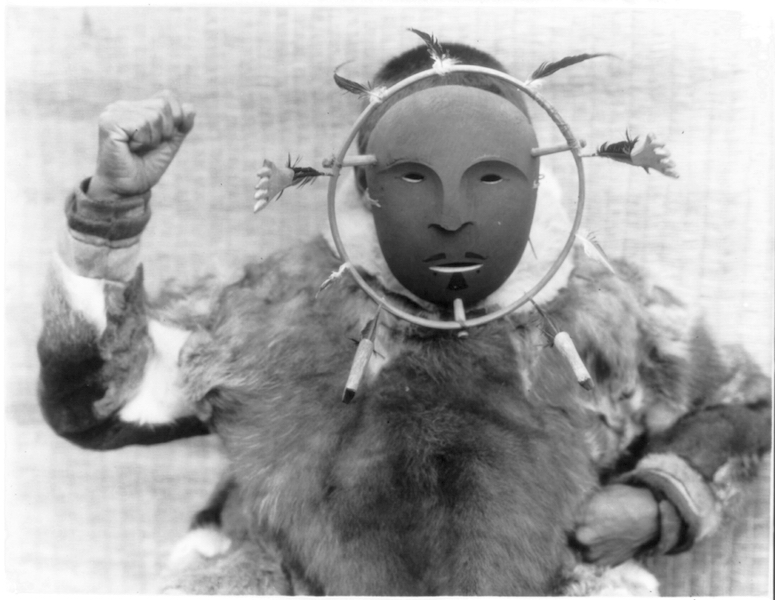
Edward S. Curtis, A man wearing a ceremonial mask of the Nunivak style (Nunivak is an island in the Bering Sea), c. 1929, photograph (Edward S. Curtis Collection, Library of Congress)
Making masks
Masking practices formed a vital component of Yup’ik culture. Masks were often made in pairs, and after they were used, the masks were typically discarded or destroyed. Only the most important—often those made and worn by the ritual specialist—might be kept and reused.
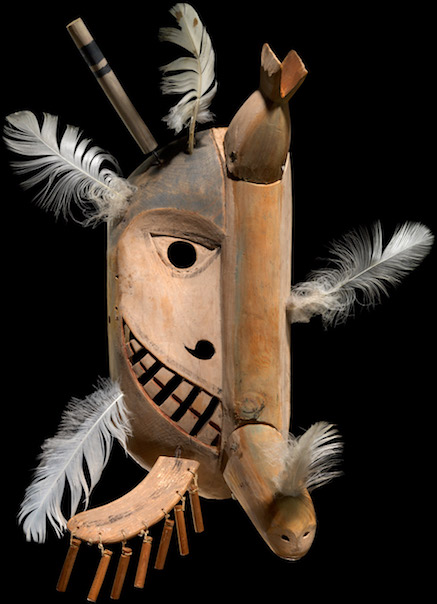
Yup´ik mask, c. 1910, Good News Bay, Alaska, driftwood, baleen, feathers, paint, cotton twine, 49 x 39 cm (National Museum of the American Indian)
Young men learned to carve by observing their family members producing masks. Ritual or spiritual specialists (frequently referred to today as “shamans”) often oversaw the carving of masks, but artists also added their own touches to them. No two masks were identical, and each had its own story.
Many different materials were used to create Yup’ik masks. In a wonderful, animated mask from around 1910 now in the National Museum of the American Indian in New York (left), a Yupik carver used driftwood, baleen, feathers, paint, and cotton twine to create a mask representing a grinning face.
The Metropolitan Museum of Art’s early twentieth-century mask (image at the top of the page) uses fewer materials—wood, paint, and feathers—and it shows Negakfok, or the North Wind (also called “the spirit that likes cold and stormy weather”). Imagine that when someone participated in a ceremony and wore this mask, the dangling wood pieces collided making noise—evoking not only the movement of wind, but also the noise it makes. The white spots may symbolize snowflakes. It calls to mind the experience of an icy wind whipping up snow—evoking the cold winters of western Alaska.
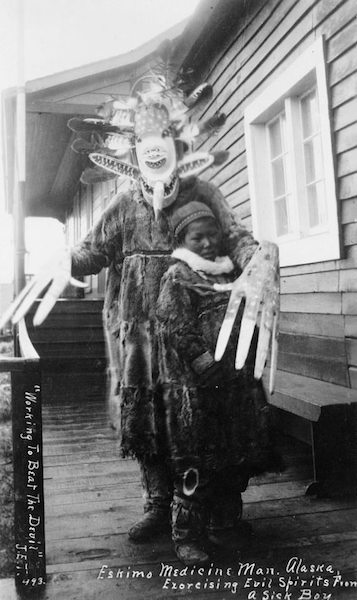
Shaman healing a sick boy, c. 1900-1930, Library of Congress
Masking ceremonies
Making masks and participating in performances helped to forge social bonds and to engage with beings in the spirit world. These beings were not only people, but also animals, and elements of the environment, and sometimes even hybrids. Spirits could be embodied by living creatures as well as objects like hunting tools, so it was crucial to respect the environment in which one lived. During ceremonies, masks transformed the individual wearing it into a spirit made manifest in the material world. This element of transformation is evident in the appearance of many masks that combine animal and human elements with others that relate to the environment. Men typically wore these masks during ceremonies, while women might use finger masks to animate their hands. Ritual specialists usually directed dances and selected which males would be masked participants.
Beyond wearing the masks, hand drums were often used during the dances. Ceremonial clothing further animated dances and worked with the masks to transform an individual into a channel for a spirit. Think of these ceremonies as a form of storytelling, with the music and masked dancing as the primary means of conveying a narrative and making contact with the spirits that aided people living in a challenging natural environment. All of these events, including the carving and painting of masks, occurred in the communal men’s house, called a qasgiq.
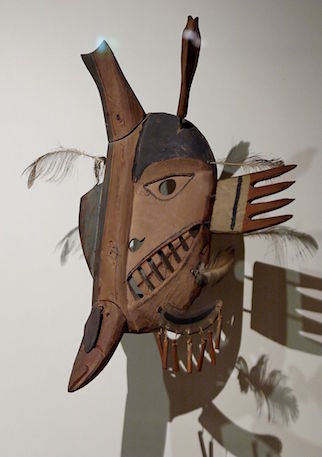
Fish mask of the Yupi’k people, wood, Yukon/Kuskokwim region (Alaska), early 20th century (Louvre, formerly in the collection of André Breton; on deposit from the Musée du quai Branly)
Changes in Yup’ik traditions
As the Yupik came into contact with Russians, Euro-Americans, and Europeans during the nineteenth century, they began to trade with groups beyond those who lived near by. As a result of increased contact with outsiders in the late nineteenth and early twentieth century however, some Yup’ik lifeways were altered, especially with attempts to Christianize them. One of the major changes that occured was the banning of masked dancing performances.
Masked dances were forbidden when outsiders deemed these rituals an impediment to Christian evangelization. Some masks were confiscated. Other masks entered private collections in the early twentieth century after they were discarded after use.
In the early twentieth century, Surrealist artists and writers collected Yup’ik masks because of their extraordinary appearance and the Surrealist interest in transformation. For instance, Andre Breton, the founder of the Surrealists, was known to have owned masks—finding inspiration in their conceptual nature. Enrico Donati, another surrealist artist, bought a mask in 1945 that recently sold in 2011 for more than two million dollars. Many of these masks were acquired from Julius Carlebach, a dealer in New York City who had sold masks to the Surrealists, and who had himself received many objects from George Gustav Heye whose collection forms the basis for the Museum of the American Indian (located in New York City and Washington, D.C.).

